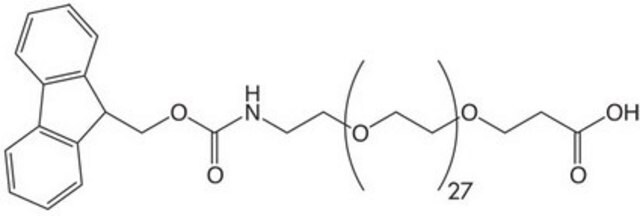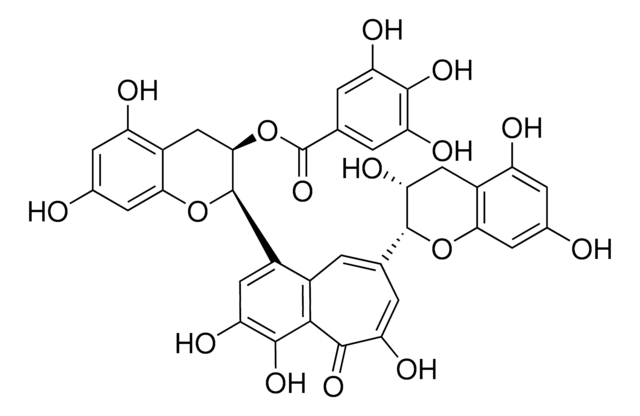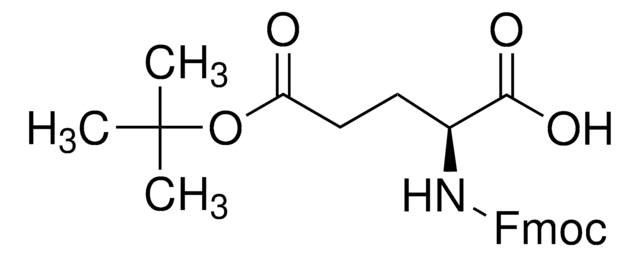Wszystkie zdjęcia(1)
Key Documents
QBD10273
Fmoc-N-amido-dPEG®8-acid
>95% (HPLC)
Synonim(y):
Fmoc-N-amido-PEG8-COOH, Fmoc-N-amido-PEG8-acid, Fmoc-NH-PEG8-acid, Fmoc-PEG-acid
Zaloguj sięWyświetlanie cen organizacyjnych i kontraktowych
About This Item
Wzór empiryczny (zapis Hilla):
C34H49NO12
Masa cząsteczkowa:
663.75
Numer MDL:
Kod UNSPSC:
12352106
NACRES:
NA.22
Polecane produkty
Próba
>95% (HPLC)
Postać
solid or viscous liquid
przydatność reakcji
reaction type: Pegylations
architektura polimerowa
shape: linear
functionality: heterobifunctional
Warunki transportu
ambient
temp. przechowywania
−20°C
Cechy i korzyści
Fmoc-N-amido-dPEG8-acid is a monodisperse PEG product that is useful for peptide synthesis. The 28-atom dPEG spacer allows the introduction of a medium-length, hydrophilic spacer onto either end of a peptide chain or between two peptide chains. The flexible dPEG spacer conjugates to peptides using conventional peptide synthesis chemistry. Peptide PEGylation imparts water solubility to hydrophobic peptide chains. Also, PEGylated peptides have expanded hydrodynamic volumes, which can reduce or eliminate renal clearance, and are protected from proteolysis. The combination of decreased renal clearance and protection from proteolysis contributes to longer in vivo circulation times for PEGylated (as compared to non-PEGylated) peptides. Additionally, PEGylation diminishes a peptide′s antigenicity. This product is part of the Fmoc-N-amido-dPEGn-acid (n=2, 3, 4, 5, 6, 8, 12, 24, 36) product series.
Informacje prawne
Products Protected under U.S. Patent #s 7,888,536 & 8,637,711 and European Patent #s 1,594,440 & 2,750,681
dPEG is a registered trademark of Quanta BioDesign
This page may contain text that has been machine translated.
Kod klasy składowania
11 - Combustible Solids
Klasa zagrożenia wodnego (WGK)
WGK 3
Temperatura zapłonu (°F)
Not applicable
Temperatura zapłonu (°C)
Not applicable
Wybierz jedną z najnowszych wersji:
Certyfikaty analizy (CoA)
Lot/Batch Number
Przepraszamy, ale COA dla tego produktu nie jest aktualnie dostępny online.
Proszę o kontakt, jeśli potrzebna jest pomoc Obsługa Klienta
Masz już ten produkt?
Dokumenty związane z niedawno zakupionymi produktami zostały zamieszczone w Bibliotece dokumentów.
Guangchang Zhou et al.
Molecular bioSystems, 8(9), 2395-2404 (2012-07-10)
Robust methods for highly parallel, quantitative analysis of cellular protein tyrosine kinase activities may provide tools critically needed to decipher oncogenic signaling, discover new targeted drugs, diagnose cancer and monitor patients. Here, we describe proof-of-principle for a novel protein kinase
Ignacio Melgar-Asensio et al.
Investigative ophthalmology & visual science, 59(10), 4071-4081 (2018-08-12)
Drug delivery by intravitreal injection remains problematic, small agents and macromolecules both clearing rapidly. Typical carriers use microparticles (>2 μm), with size-related liabilities, to slow diffusion. We recently described cationic nanoparticles (NP) where conjugated Arg peptides prolonged residence in rat
Ian W Hamley
Biomacromolecules, 15(5), 1543-1559 (2014-04-12)
The remarkable diversity of the self-assembly behavior of PEG-peptides is reviewed, including self-assemblies formed by PEG-peptides with β-sheet and α-helical (coiled-coil) peptide sequences. The modes of self-assembly in solution and in the solid state are discussed. Additionally, applications in bionanotechnology
Nasz zespół naukowców ma doświadczenie we wszystkich obszarach badań, w tym w naukach przyrodniczych, materiałoznawstwie, syntezie chemicznej, chromatografii, analityce i wielu innych dziedzinach.
Skontaktuj się z zespołem ds. pomocy technicznej








